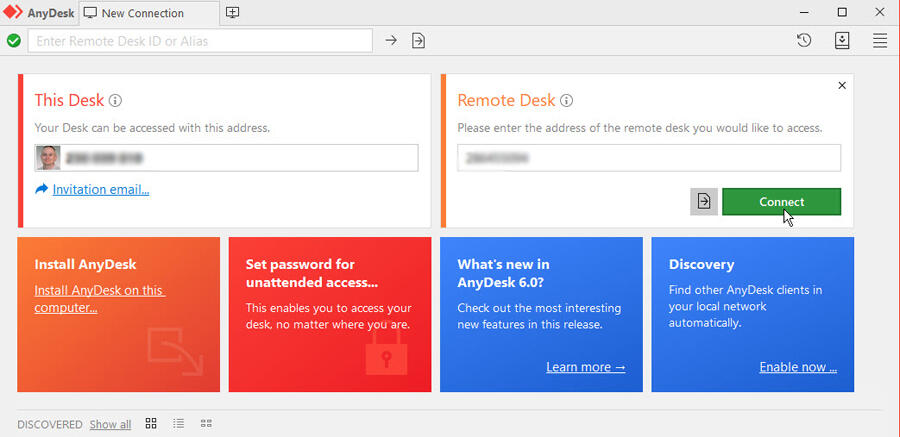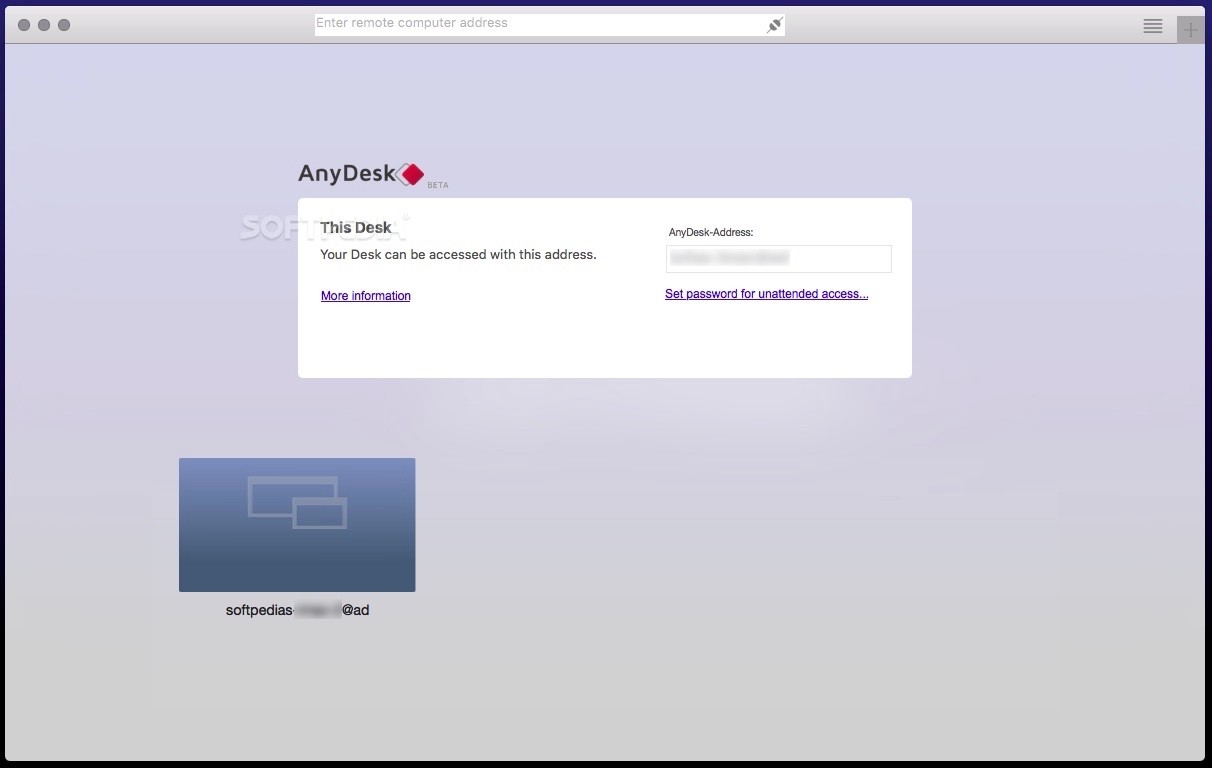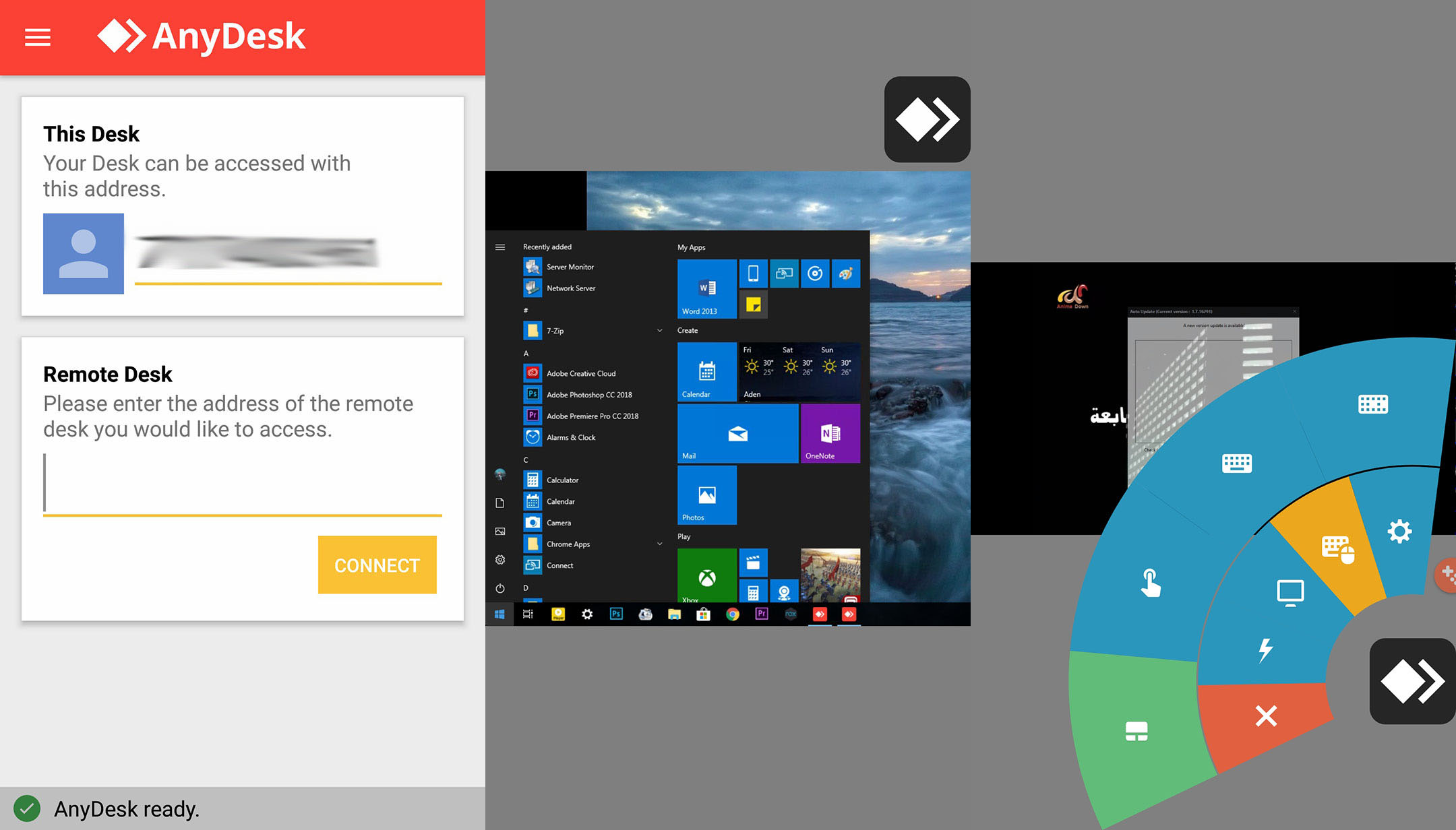AnyDesk prompt to enter credentials for the remote client Actions Menu with no option to request elevation, indicating that AnyDesk is already installed on the remote client. AnyDesk provides the option to run as administrator (elevated), which enables the user to control applications that are limited to administrators. AnyDesk can then be used for Remote View only. A possible workaround is to use the adb shell. The plugin can be enabled using the following command: adb shell settings put secure enabledaccessibilityservices com.anydesk.adcontrol.ad1/com.anydesk.adcontrol.AccService.
- This company scammed me out of thousands of pounds worth of my purchased bitcoins by using a remote computer software programme called 'anydesk'. Without me realising, they deceptively transferred all my bitcoins to a mystery, untraceable bitcoin receiving wallet.
- The AnyDesk Audio Feature transmits sound from the remote device to the local device. It can be enabled or disabled in the 'Permissions'-section of the Accept Window before or during an AnyDesk session, as well as in the 'Permissions'-settings at the top of the AnyDesk window during a session.
What Is Screen Sharing?
Screen sharing allows us to virtually look over each other’s shoulder and view each other’s screen from anywhere in the world in real-time, without having to send each other screenshots or a screen recording.
But what do you need screen sharing for? Think about the many times at the office when you walked over to a coworker’s cubicle and discussed something on their screen. What were the reasons? Maybe they showed you how to use the new tool implemented by IT. Maybe they projected their screen onto the wall in a meeting in order to show you a presentation. Maybe they wanted you to see what they are working on without having to send you a file first and they wanted to guide you through their work in real-time.
In times where more and more people are working from home, these little moments get lost. Thankfully, all of these cases can be recreated virtually using a screen sharing tool. In this step-by-step guide, we will show you how to screen share using our remote desktop solution.
How to Screen Share With AnyDesk
If you want to share your screen with someone, here’s what you do.
1. First, download AnyDesk. You can either download it for free or, if you need advanced functions, get one of our affordable and scalable licenses. Either way, as soon as you open AnyDesk for the first time, you’ll see a field titled “This Desk,” where you’ll find your ID – the number or alias that can be used to contact you.
2. Send your ID to the person you want to share your screen with and ask them to enter it into the “Remote Desk” field. Another way is to send them an invitation. Look again under “This Desk” and click on the “Invitation email” link. After the session, your ID will be saved in your guest’s “Recent Sessions,” so whenever they need to contact you again, they can do so with one click.
3. Whatever you decide to do, the next step is to wait for your guest to enter your ID and send you a session request. Notice the accept window that pops up when you receive their session request. Before you accept, you can already set your permissions there.
If this remote desktop session is merely for screen sharing, we advise unticking most, if not all permissions, so that the other side cannot interact with your desktop. This means denying the use of mouse and keyboard, preventing them from using the clipboard and file manager, and disabling the On-Screen Whiteboard.
Of course, the chat function will still be enabled and it’s a good way to communicate with your guest if questions arise or if you’d like to clarify something. However, our tip is to still allow the session to be recorded. This is helpful if, for example, you host a tutorial via screen sharing. It allows your guest to re-watch the session at any time.
These permissions can also be set in the security settings before the session and can always be changed during a session. Maybe your guest would like to visualize something on your screen? You can then allow them to use the On-Screen Whiteboard.
What Else Can You Do With AnyDesk?
After your presentation ends, you can disconnect your guest on the accept window. As you see, AnyDesk is a simple way to share your screen without having to worry about the connection being unstable or lagging.
But that’s not all AnyDesk is capable of! From simple screen sharing to complicated IT administration tasks, AnyDesk has features for every remote desktop need and high security standards. Try it out for yourself!
AnyDesk virus removal instructions

What is AnyDesk?
Similar to TeamViewer, AnyDesk, is a legitimate application that provides remote system control functionality. Recently, however, cyber criminals have started distributing a modified version of AnyDesk using the 'bundling' method, and thus it typically infiltrates without users’ permission.
The modified version is also used to remotely access systems, but without users' consent. The malicious version essentially runs in the background and waits for regular users to leave the computer unattended for a certain period. Once the user is 'away from the keyboard', cyber criminals remotely connect to the system and perform malicious actions. In most cases, these people target users' Amazon accounts. They use saved logins/passwords to sign into the Amazon website and purchase various items and gift cards. Amazon is not the only account at risk. Cyber criminals can do whatever they wish with access to the system (e.g., install other malware, steal logins/passwords, abuse social networks and other personal accounts, etc.) Therefore, the presence of AnyDesk's modified version can lead to high-risk computer infections and serious privacy issues. The desktop shortcut of the malicious version is called 'AnyDask' and its entry in the list of installed programs is 'AnyDeskApp'. If you notice that AnyDesk has infiltrated systems without your consent, or you have downloaded it from a third party source, immediately eliminate it and scan the system with a reputable anti-virus/anti-spyware suite to remove all remnants. AnyDesk should be downloaded from its official website only.
| Name | AnyDesk malware |
| Threat Type | Adware, Unwanted ads, Pop-up Virus |
| Symptoms | Seeing advertisements not originating from the sites you are browsing. Intrusive pop-up ads. Decreased Internet browsing speed. |
| Distribution methods | Deceptive pop-up ads, free software installers (bundling), fake flash player installers. |
| Damage | Decreased computer performance, browser tracking - privacy issues, possible additional malware infections. |
| Malware Removal (Windows) | To eliminate possible malware infections, scan your computer with legitimate antivirus software. Our security researchers recommend using Malwarebytes. |
At time of research, AnyDesk is bundled together with a number of other potentially unwanted programs (PUPs), including Powzip, Smart Application Controller, One System Care, View, and mail.ru. Unlike AnyDesk, these potentially unwanted programs do not provide remote access to victims' computers. They deliver intrusive advertisements (adware), cause unwanted redirects (browser hijackers), and record various sensitive data (virtually all types). Note that PUPs offer 'useful functionality', and yet these programs are designed only to generate revenue for the developers. Thus, claims to provide these functions are merely attempts to give the impression of legitimacy.
How did adware install on my computer?
As mentioned above, AnyDesk is distributed using a deceptive marketing method called 'bundling' - stealth installation of third party applications together with regular software/apps. In most cases, 'bundled' applications are hidden within 'Custom/Advanced' options (or other sections) of the download/installation processes. Developers do not disclose this information properly. Furthermore, users are likely to rush when downloading/installing software and skip steps. In doing so, they expose their systems to risk of various infections and compromise their privacy.
How to avoid installation of potentially unwanted applications?
Poor knowledge and careless behavior are the main reasons for computer infections. The key to safety is caution. Therefore, pay close attention when browsing the Internet and downloading/installing software. Select 'Custom/Advanced' settings, carefully analyze each window of the download/installation dialogs, and opt-out of all additionally-included programs. Software should be downloaded from official sources only via direct download links. Third party downloaders/installers are monetized using the 'bundling' method, and thus these tools should never be used. Be aware that cyber criminals also proliferate PUPs using intrusive advertisements that redirect to malicious websites and execute scripts that download/install PUPs. Most of these ads will seem legitimate, since developers invest many resources into their design, however, they redirect to adult dating, pornography, gambling, and other rogue sites. These ads are often delivered by adware. Therefore, if you experience suspicious redirects, eliminate all dubious applications and browser plug-ins. Having a reputable anti-virus/anti-spyware software installed and running is also paramount. If your computer is already infected with AnyDesk, we recommend running a scan with Malwarebytes for Windows to automatically eliminate this adware.
Anydesk Remote Download
Deceptive installer distributing modified AnyDesk version (note that it is completely concealed and, therefore, opting-out is impossible):
Instant automatic malware removal:Manual threat removal might be a lengthy and complicated process that requires advanced computer skills. Malwarebytes is a professional automatic malware removal tool that is recommended to get rid of malware. Download it by clicking the button below:
▼ DOWNLOAD MalwarebytesBy downloading any software listed on this website you agree to our Privacy Policy and Terms of Use. To use full-featured product, you have to purchase a license for Malwarebytes. 14 days free trial available.
Quick menu:
- STEP 1. Uninstall AnyDesk using Control Panel.
- STEP 2. Remove adware from Internet Explorer.
- STEP 3. Remove rogue plug-ins from Google Chrome.
- STEP 4. Remove adware-type extensions from Mozilla Firefox.
- STEP 5. Remove malicious extensions from Safari.
- STEP 6. Remove rogue plug-ins from Microsoft Edge.
AnyDesk removal:
Windows 7 users:
Click Start (Windows Logo at the bottom left corner of your desktop), choose Control Panel. Locate Programs and click Uninstall a program.
Windows XP users:
Click Start, choose Settings and click Control Panel. Locate and click Add or Remove Programs.
Windows 10 and Windows 8 users:
Right-click in the lower left corner of the screen, in the Quick Access Menu select Control Panel. In the opened window choose Programs and Features.
Mac OSX users:
Click Finder, in the opened screen select Applications. Drag the app from the Applications folder to the Trash (located in your Dock), then right click the Trash icon and select Empty Trash.
In the uninstall programs window, look for 'AnyDeskApp' and other potentially unwanted programs, select these entries and click 'Uninstall' or 'Remove'.
After uninstalling the potentially unwanted program that causes AnyDesk redirects, scan your computer for any remaining unwanted components or possible malware infections. To scan your computer, use recommended malware removal software.
Malwarebytes checks if your computer is infected with malware. To use full-featured product, you have to purchase a license for Malwarebytes. 14 days free trial available.
Remove adware from Internet browsers:
Video showing how to remove potentially unwanted browser add-ons:
Remove malicious add-ons from Internet Explorer:
Click the 'gear' icon (at the top right corner of Internet Explorer), select 'Manage Add-ons'. Look for any recently-installed suspicious browser extensions, select these entries and click 'Remove'.
Optional method:
If you continue to have problems with removal of the anydesk malware, reset your Internet Explorer settings to default.
Windows XP users: Click Start, click Run, in the opened window type inetcpl.cpl In the opened window click the Advanced tab, then click Reset.

Windows Vista and Windows 7 users: Click the Windows logo, in the start search box type inetcpl.cpl and click enter. In the opened window click the Advanced tab, then click Reset.
Windows 8 users: Open Internet Explorer and click the gear icon. Select Internet Options.
In the opened window, select the Advanced tab.
Click the Reset button.
Confirm that you wish to reset Internet Explorer settings to default by clicking the Reset button.
Remove malicious extensions from Google Chrome:
Click the Chrome menu icon (at the top right corner of Google Chrome), select 'More tools' and click 'Extensions'. Locate all recently-installed suspicious browser add-ons and remove them.
Optional method:
If you continue to have problems with removal of the anydesk malware, reset your Google Chrome browser settings. Click the Chrome menu icon (at the top right corner of Google Chrome) and select Settings. Scroll down to the bottom of the screen. Click the Advanced… link.
After scrolling to the bottom of the screen, click the Reset (Restore settings to their original defaults) button.

In the opened window, confirm that you wish to reset Google Chrome settings to default by clicking the Reset button.
Anydesk Remote Start
Remove malicious plug-ins from Mozilla Firefox:
Click the Firefox menu (at the top right corner of the main window), select 'Add-ons'. Click 'Extensions', in the opened window, remove all recently-installed suspicious browser plug-ins.
Anydesk Remote Control
Optional method:
Computer users who have problems with anydesk malware removal can reset their Mozilla Firefox settings.
Open Mozilla Firefox, at the top right corner of the main window, click the Firefox menu, in the opened menu, click Help.
Select Troubleshooting Information.
In the opened window, click the Refresh Firefox button.
In the opened window, confirm that you wish to reset Mozilla Firefox settings to default by clicking the Refresh Firefox button.
Remove malicious extensions from Safari:
Make sure your Safari browser is active, click Safari menu, and select Preferences....
In the opened window click Extensions, locate any recently installed suspicious extension, select it and click Uninstall.
Optional method:
Make sure your Safari browser is active and click on Safari menu. From the drop down menu select Clear History and Website Data...
In the opened window select all history and click the Clear History button.
Remove malicious extensions from Microsoft Edge:
Click the Edge menu icon (at the upper-right corner of Microsoft Edge), select 'Extensions'. Locate all recently-installed suspicious browser add-ons and click 'Remove' below their names.
Optional method:
If you continue to have problems with removal of the anydesk malware, reset your Microsoft Edge browser settings. Click the Edge menu icon (at the top right corner of Microsoft Edge) and select Settings.
In the opened settings menu select Reset settings.
Select Restore settings to their default values. In the opened window, confirm that you wish to reset Microsoft Edge settings to default by clicking the Reset button.
- If this did not help, follow these alternative instructions explaining how to reset the Microsoft Edge browser.
Summary:
Anydesk Remote Control Android
Commonly, adware or potentially unwanted applications infiltrate Internet browsers through free. software downloads. Note that the safest source for downloading free software is via developers' websites only. To avoid installation of adware, be very attentive when downloading and installing free software. When installing previously-downloaded free programs, choose the custom or advanced installation options – this step will reveal any potentially unwanted applications listed for installation together with your chosen free program.
Removal assistance:
If you are experiencing problems while trying to remove anydesk malware from your computer, please ask for assistance in our malware support forum.

Anydesk Remote Software Download
Post a comment:
If you have additional information on anydesk malware or it's removal please share your knowledge in the comments section below.
